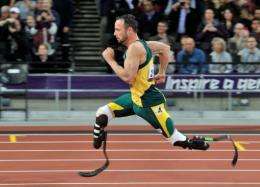Science 'unclear' over Pistorius claims

The International Paralympic Committee on Monday defended its policy on artificial running blades for amputee athletes, insisting it was the best possible system.
But Peter Van Der Vliet, the IPC's medical and scientific director, admitted that the rules may still need to be looked at, after beaten Paralympic champion Oscar Pistorius questioned the validity of his rivals' prostheses.
Pistorius, the most high-profile athlete at the London Games after he competed in the Olympics last month, said he had been at a disadvantage in terms of leg length after losing his T44 200m crown on Sunday.
The IPC rejected his claims and Van Der Vliet said the rules, designed to ensure artificial limbs are proportional to an athlete's body, were "the best system in place and to the confidence and satisfaction of all involved".
Upper limits for artificial leg lengths are calculated using a mathematical formula based on the length of an athlete's arm span as well as the distance from their sternum (chest) to the tip of the affected limb or limbs.
An additional 3.5 percent of that calculation is factored in to replicate running action, where a non-disabled athlete runs on his or her toes, he explained.
The measuring system used to calculate limb length was developed in consultation with athletes, coaches and federations before being sent to the IPC's governing body for approval.
Classification and the use of adaptive equipment tailored to the individual needs of each athlete's particular impairment are unique to Paralympic sport.
Athletes are grouped according to the nature and extent of their impairment, but a lack of athletes in one category can mean they compete with those from another.
Pistorius, for example, is a double below-the-leg amputee (T43) athlete but often runs against T44 (single below-the-knee amputee) competitors in the same race.
Van Der Vliet said determining the categories and rules on equipment was a complex and constantly evolving process.
"In the length of prosthetics, we fall back on existing scientific literature in establishing the best length. That is translated into rules and regulations," he told a news conference.
But he said the Pistorius controversy had shown the complexity of the issue.
"You can't compare two sets of (running) blades, two sets of prostheses. They're all unique," he added.
Pistorius himself has had to prove that his J-shaped Flex-Foot "Cheetah" blades, made by prosthetics firm Ossur, did not give him an unfair advantage when running against non-disabled athletes.
But in claiming that he was only beaten because he could not compete with his rivals' superior leg length, he has re-opened the debate.
"You can't help but see the irony of it, really," said David James, senior lecturer at the Centre for Sports Engineering Research at Sheffield Hallam University in northern England.
"Pistorius has always insisted that his blades don't enhance his performance, merely enable it—and now he's arguing that this other guy's (winner Alan Oliveira of Brazil) performance has been enhanced by his blades," he told AFP.
Pistorius had been banned from competing against non-disabled athletes until 2008, amid claims that he expends less energy than a non-disabled competitor running at the same speed.
But he successfully challenged that by putting forward arguments that this was cancelled out by his slower start from the blocks and acceleration.
James maintained that Pistorius does have an advantage over non-disabled athletes because blades, costing up to 10,000 euros (£7.925, $12,500) each, are lighter, allowing a faster stride.
But prosthetist Donna Fisher said: "It's not the blade that does the running—it's the person who uses it."
Fisher, who works for Ottobock, which provides repairs for Paralympic athletes, added: "The blades will give energy back out, but the energy is equal to the energy that goes in—and that's powered by the athletes."
Van Der Vliet said the scientific situation was unclear, as there was no single, comprehensive study into how blades impact on overall performance.
"Technology is one of those components that will require more in depth detail," he said. "It's something we will look into."
(c) 2012 AFP


















